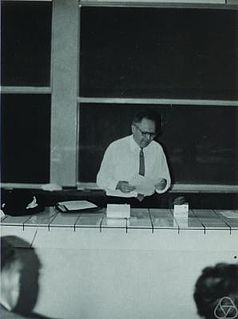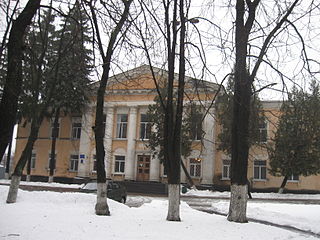In complex analysis, de Branges's theorem, or the Bieberbach conjecture, is a theorem that gives a necessary condition on a holomorphic function in order for it to map the open unit disk of the complex plane injectively to the complex plane. It was posed by Ludwig Bieberbach (1916) and finally proven by Louis de Branges (1985).
In mathematics, an exponential sum may be a finite Fourier series, or other finite sum formed using the exponential function, usually expressed by means of the function

In mathematics, Diophantine geometry is the study of points of algebraic varieties with coordinates in the integers, rational numbers, and their generalizations. These generalizations typically are fields that are not algebraically closed, such as number fields, finite fields, function fields, and p-adic fields. It is a sub-branch of arithmetic geometry and is one approach to the theory of Diophantine equations, formulating questions about such equations in terms of algebraic geometry.
In mathematics, the Mahler measureof a polynomial with complex coefficients is defined as
This is a glossary of arithmetic and diophantine geometry in mathematics, areas growing out of the traditional study of Diophantine equations to encompass large parts of number theory and algebraic geometry. Much of the theory is in the form of proposed conjectures, which can be related at various levels of generality.
A height function is a function that quantifies the complexity of mathematical objects. In Diophantine geometry, height functions quantify the size of solutions to Diophantine equations and are typically functions from a set of points on algebraic varieties to the real numbers.
In mathematics, real algebraic geometry is the study of real algebraic sets, i.e. real-number solutions to algebraic equations with real-number coefficients, and mappings between them.
Alexander A. Beilinson is the David and Mary Winton Green University Professor at the University of Chicago and works on mathematics. His research has spanned representation theory, algebraic geometry and mathematical physics. In 1999 Beilinson was awarded the Ostrowski Prize with Helmut Hofer. In 2017 he was elected to the National Academy of Sciences.
Vladimir Gilelevich Maz'ya is a Russian-born Swedish mathematician, hailed as "one of the most distinguished analysts of our time" and as "an outstanding mathematician of worldwide reputation", who strongly influenced the development of mathematical analysis and the theory of partial differential equations. His early achievements include: his work on Sobolev spaces, in particular the discovery of the equivalence between Sobolev and isoperimetric/isocapacitary inequalities (1960), his counterexamples related to Hilbert's 19th and Hilbert's 20th problem (1968), his solution, together with Yuri Burago, of a problem in harmonic potential theory (1967) posed by Riesz & Nagy, his extension of the Wiener regularity test to p–Laplacian and the proof of its sufficiency for the boundary regularity. Maz'ya solved V. Arnol'd's problem for the oblique derivative boundary value problem (1970) and F. John's problem on the oscillations of a fluid in the presence of an immersed body (1977). In recent years, he proved a Wiener's type criterion for higher order elliptic equations, together with M. Shubin solved a problem in the spectral theory of the Schrödinger operator formulated by Israel Gelfand in 1953, found necessary and sufficient conditions for the validity of maximum principles for elliptic and parabolic systems of PDEs and introduced the so–called approximate approximations. He also contributed to the development of the theory of capacities, nonlinear potential theory, the asymptotic and qualitative theory of arbitrary order elliptic equations, the theory of ill-posed problems, the theory of boundary value problems in domains with piecewise smooth boundary.
In complex analysis, a branch of mathematics, the Koebe 1/4 theorem states the following:
Koebe Quarter Theorem. The image of an injective analytic function f : D → C from the unit disk D onto a subset of the complex plane contains the disk whose center is f(0) and whose radius is |f′(0)|/4.
In mathematics, the Lebedev–Milin inequality is any of several inequalities for the coefficients of the exponential of a power series, found by Lebedev and Milin (1965) and Isaak Moiseevich Milin (1977). It was used in the proof of the Bieberbach conjecture, as it shows that the Milin conjecture implies the Robertson conjecture.

Vasily Sergeyevich Vladimirov was a Soviet mathematician and mathematical physicist working in the fields of number theory, mathematical physics, quantum field theory, numerical analysis, generalized functions, several complex variables, p-adic analysis, multidimensional tauberian theorems.

Vyacheslav Ivanovich Lebedev was a Soviet and Russian mathematician, known for his work on numerical analysis.
In mathematics, the Fekete–Szegő inequality is an inequality for the coefficients of univalent analytic functions found by Fekete and Szegő (1933), related to the Bieberbach conjecture. Finding similar estimates for other classes of functions is called the Fekete–Szegő problem.
In mathematics, the Grunsky matrices, or Grunsky operators, are matrices introduced by Grunsky (1939) in complex analysis and geometric function theory. They correspond to either a single holomorphic function on the unit disk or a pair of holomorphic functions on the unit disk and its complement. The Grunsky inequalities express boundedness properties of these matrices, which in general are contraction operators or in important special cases unitary operators. As Grunsky showed, these inequalities hold if and only if the holomorphic function is univalent. The inequalities are equivalent to the inequalities of Goluzin, discovered in 1947. Roughly speaking, the Grunsky inequalities give information on the coefficients of the logarithm of a univalent function; later generalizations by Milin, starting from the Lebedev–Milin inequality, succeeded in exponentiating the inequalities to obtain inequalities for the coefficients of the univalent function itself. Historically the inequalities were used in proving special cases of the Bieberbach conjecture up to the sixth coefficient; the exponentiated inequalities of Milin were used by de Branges in the final solution. The Grunsky operators and their Fredholm determinants are related to spectral properties of bounded domains in the complex plane. The operators have further applications in conformal mapping, Teichmüller theory and conformal field theory.
Albert "Al" Charles Schaeffer was an American mathematician who worked on complex analysis.
Adolph Winkler Goodman was an American mathematician who contributed to number theory, graph theory and to the theory of univalent functions: The conjecture on the coefficients of multivalent functions named after him is considered the most interesting challenge in the area after the Bieberbach conjecture, proved by Louis de Branges in 1985.

Alexander Nikolaevich Varchenko is a Soviet and Russian mathematician working in geometry, topology, combinatorics and mathematical physics.
Menahem Max Schiffer was a German-born American mathematician who worked in complex analysis, partial differential equations, and mathematical physics.
Mathematical Reviews is a journal published by the American Mathematical Society (AMS) that contains brief synopses, and in some cases evaluations, of many articles in mathematics, statistics, and theoretical computer science. The AMS also publishes an associated online bibliographic database called MathSciNet which contains an electronic version of Mathematical Reviews and additionally contains citation information for over 3.5 million items as of 2018.

In computing, a Digital Object Identifier or DOI is a persistent identifier or handle used to identify objects uniquely, standardized by the International Organization for Standardization (ISO). An implementation of the Handle System, DOIs are in wide use mainly to identify academic, professional, and government information, such as journal articles, research reports and data sets, and official publications though they also have been used to identify other types of information resources, such as commercial videos.

JSTOR is a digital library founded in 1995. Originally containing digitized back issues of academic journals, it now also includes books and other primary sources, and current issues of journals. It provides full-text searches of almost 2,000 journals. As of 2013, more than 8,000 institutions in more than 160 countries had access to JSTOR; most access is by subscription, but some of the site's public domain and open access content is available at no cost to anyone. JSTOR's revenue was $86 million in 2015.






